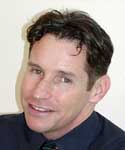-
- Schools examine lessons of Massachusetts same-sex marriages
- New Virginia law causes some gays to consider leaving state
- Newly married lesbian couple files lawsuit over cancer
- Timing of same-sex marriage vote may hinge on definitions
- Parents turn to courts to stop bullying
- Governor tries to find his way through politically treacherous ground
- National News Briefs
- World News Briefs
commentary
Free speech – and no speech – at Carlsbad High
Published Thursday, 27-May-2004 in issue 857
Beyond the Briefs
As recently reported by Travis D. Bone in the May 13 issue of the Gay & Lesbian Times, more than a dozen students at Carlsbad High School ended up in the principal’s office on April 21. Why? Because they wanted to remain silent in order to observe the national Day of Silence.
On national Day of Silence each year, students across the country, both straight and gay, take a vow of silence for the entire school day in protest of the suffering GLBT students endure on a daily basis. Mirroring our local Carlsbad story, in the news recently was the case of Jarred Gamwell, a 17-year-old junior at James Hunt High School in Wilson, North Carolina, who ran for student body office with the slogan “Queer Eye for Hunt High”. School officials tore down his posters, arguing they were “offensive.” At Hillcrest High School (yes, there is one), in Utah, school officials told students they could not wear T-shirts saying “Queers Kick Ash”. School officials indicated that the T-shirts violated school policy against wearing apparel that could be offensive to other students.
Each one of these cases presents creative legal problems for school officials and their attorneys. But remaining silent in a classroom presents a novel issue. In a school setting, this can create some problems, especially when teachers call upon a student in a class and the student refuses to talk. One could argue that under the Education Code students can suffer discipline for refusing to obey a lawful request by a school official.
In 1969, in the landmark Supreme Court case Tinker v. Des Moines School District, the court held that “students don’t shed their rights at the schoolhouse gate.” In Tinker, similarly to the students in Carlsbad, high school students wore black armbands in school to symbolically protest the Vietnam War. The court held students have First Amendment rights while on public school grounds.
However, schools can limit student speech by prescribing reasonable time, place and manner limits. If student speech materially and substantially disrupts the school, schools can ban it altogether. School officials, for instance, do not have to allow “gang colors” to be worn on school because it could result not just in disruption, but a few deaths. Students cannot get up in the middle of math class and begin protesting the Iraq war. That would be disruptive. Wearing a pink ribbon is not. In Tinker, the court found wearing black armbands in school, even in the classroom, did not materially and substantially disrupt the educational process.
But refusing to talk in class could, arguably, be viewed as disruptive. As a law teacher, if all my students won’t talk I can’t conduct a debate. To their credit, students at Carlsbad’s Gay Straight Alliance sought consent to observe the day, but school officials said it was “testing” day and turned down their request.
According to teacher Kurt Dearie (GSA advisor), knowing the students were going to remain silent on April 21, a teacher decided to have a surprise oral presentation so students could be removed for “disturbing class”.
Reports suggest that as many as 15 students were removed from class throughout the day.
I find this troubling because Ren Petty (writing in Update’s April 29 issue) reported that this teacher wrote to an openly gay student that “his is an unhealthy immoral lifestyle choice that degrades the stability of society.”
Singling out those students for punitive action violates free speech and equal protection. Otherwise, I think we lose on “silence in the classroom” because judges will find it can be disruptive, well intentioned as it might be. The key issue is whether the silence caused a “substantial” disruption.
Keep in mind that the First Amendment applies to those students who choose to promote “straight pride.” The same rights that apply to gay students apply to straight students. A lesbian teenager recently recovered $30,000 when school officials in New York made her remove a “Barbie is a Lesbian” T-shirt. However, last year I wrote about a student who won his suit when a school principal made him remove his “Straight Pride” T-shirt, even though the school had some gay-related hate crimes. Ironically, it is this latter case that will help Jarred Gamwell and the “Kick Ash” students in Utah.
In the Carlsbad case, it’s important for the students to pursue their case. A homophobic teacher needs to be weeded out of the system, just as openly racist teachers need to be removed by school districts. Federal and state laws prohibit a hostile environment for gay students. Even if a teacher couches her hatred for gays by references to the Bible, it’s illegal.
Teachers can certainly harbor their own religious and political beliefs. But expressing those views to a student and acting in a punitive way towards students is not lawful.
|
|
Copyright © 2003-2025 Uptown Publications


